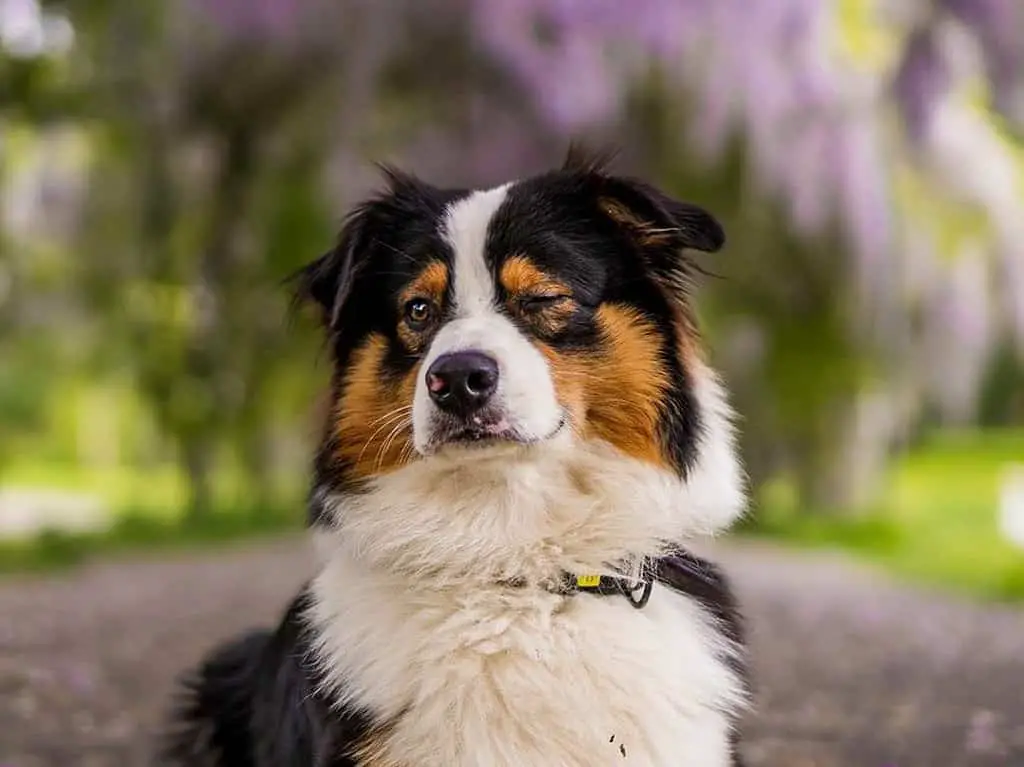Have you ever caught your pooch winking back at you? Or even slightly closing one eye to give off a subtle wink? It’s one of those moments that make you chuckle. But have you ever wondered why dogs do it?
As much as you’d love to believe our pups are cheeky and playful, it could be more than playfulness. There are, in fact, multiple reasons why dogs respond to our wink with one of their own.
Why do dogs wink back at you? What could they be trying to tell you? Find out now.

Dog Winking vs. Blinking
While winking and blinking behaviors in dogs may appear similar, they serve distinctly different purposes. Blinking, just like in humans, is an involuntary motion meant to lubricate and protect the eyes from foreign particles or harm; it involves the rapid successive closing and opening of both eyelids at once. This action is frequently observed in dogs as part of their natural eye functioning. This means that it does not typically indicate communication or a willfully executed action.
Contrarily, winking in dogs is a deliberate and conscious behavior that they may display in specific scenarios. Dogs do this as a method of communication, which could signify a request for attention or engagement from their owners or companions. Winking is most commonly observed during periods of entertainment and socialization with other pets.
So it all adds up to this – there is a distinct difference between the motivations and meanings of winking and blinking in dogs, despite both involving the outwardly similar action of closing and opening their eyes.
Why Do Dogs Wink Bank At You
Imitation
Dogs have developed the ability to recognize and repeat human behavior throughout their evolution as domesticated creatures. When an individual winks at them, it usually creates an enjoyable situation for the dog, often involving comforting words or rewarding snacks. Because of this pattern of behavior lasting various encounters, dogs essentially learn that winking generates positive experiences.
Besides, dogs can discern nonverbal communication from their owners, responding quickly and effectively. After perceiving an owner-initiated wink, dogs mirror this facial expression to foster their connection. This behavior could manifest the animal’s desire to interact more with its guardian or strengthen its social bond.
Furthermore, dogs have a knack for recognizing human emotions. They can observe and appreciate their owner’s feelings, sometimes responding with behavior mirroring the emotion of their owners, such as when they receive a wink as an indicator of friendliness or playfulness. This creates a sense of companionship between the dog and owner and facilitates understanding through empathy.
Submission
It is also possible that dogs winking back at their owners is a sign of submission. This phenomenon is not exclusive to dogs, as many animals in the animal kingdom exhibit this behavior for social stability within their group. In the context of a dog-owner relationship, it can be argued that the dog views its owner as an alpha figure and instinctively responds with submissiveness through winking. Thus, this could be seen as a way for dogs to convey respect or recognition of their owner’s authority.

Playfulness
Humans have traditionally used winking to communicate playfulness, and research has indicated that dogs are remarkably skilled at interpreting human expressions as well. In particular, a dog can easily pick up their owners’ emotions. When an owner winks at their dog, they may understand it as a fun invitation or secret message; in response, the dog might therefore wink back to join the playful interaction. It thus serves as a form of social bonding between humans and their pets.
Seek Reassurance
Dogs have highly developed senses, allowing them to detect subtle cues from their owners. In an attempt to alleviate any anxious or weird feelings, dogs may use winking as a way of showing vulnerability and asking for comfort. This behavior serves as a form of communication between the dog and its owner, representing the emotion the dog feels and highlighting its want for support from its trusted caregiver.
Seek Attention
Certain dog breeds take pleasure in garnering the attention of their respective owners and, as such, can display behaviors designed to be inviting. This could include winking at you, which they understand produces a response from their caregivers and reinforces this behavior.
Obtain Rewards
As explained, dogs wink at their owners in response to positive reinforcement, expecting a reward for exhibiting the behavior. Dogs are known to be sensitive to encouragement and, if presented with rewards such as treats, attention, or playtime after their winking, will likely learn that this behavior is met favorably. Therefore, when a dog winks at their owner, it is possible this action was learned in anticipation of obtaining the said reward.
Can Dogs Learn to Wink on Command?
Yes, dogs can be conditioned to obey multiple commands, such as winking on command. Domesticated dogs have the potential to learn a broad spectrum of functions through structured training routines and can be appropriately rewarded for their obedience.
To teach a dog to wink on command, you can follow these steps:
Start with basic obedience training: Establishing a foundation of obedience training is essential before teaching a particular trick, such as winking. Make sure your dog understands and reliably responds to fundamental commands, including “sit,” “stay,” and “down.”
Choose a unique cue: Select a distinct prompt or directive word to signify when you would like your dog to wink. Possibilities may include “wink,” “cute,” or any other custom phrase.
Associate the cue with the action: Start the training by verbalizing the cue word while lightly touching your dog’s eyelid or near its eye. Speak clearly and express your approval of their behavior. This process should be repeated multiple times for your pup to begin forming an understanding between the command and the sensation near their eye.
Gradual reinforcement: As your dog establishes a link between the command word and the stimulus, gradually withdraw the touch near their eye. Keep verbalizing the command word, and if your dog blinks or closes only one eye, regardless of how slightly, acknowledge them with praise, rewards, or a clicker if you practice clicker training.
Add a visual cue: After your pooch has consistently demonstrated comprehension of the verbal cue, you may add visual reinforcement to amplify further and refine the behavior. To accomplish this, you can wink while simultaneously giving a verbal prompt for the intended activity; in response, your furry friend will likely imitate your gesture.
Practice and repetition: Repetition is vital to creating lasting behavioral reinforcement. Familiarize your dog with the winking command in various settings and environments while gradually building up distractions. Patience and persistence are key; reward each correct response from your dog.
Remember that each dog’s ability to learn tricks will vary; certain breeds may be more likely to master specific behaviors.
Why Some Dogs Don’t Wink Back
Several factors can contribute to why some dogs don’t wink back.
Firstly, it’s essential to consider individual differences in dog behavior and temperament. Much like humans, dogs possess individual characters and dispositions. Often, winking may not be perceived by certain dogs as a cue with much significance or pleasure derived from it; they could lack prior exposure to this gesture or haven’t connected it with any particular response or compensation.
Secondly, the individual reaction to winking can differ from dog to dog – owing to their ability to understand cues and body language. Some dogs may be unable to detect or comprehend winking as a meaningful cue or not recognize it altogether.
Additionally, previous experiences and a dog’s socialization can affect its behavior. Dogs not exposed to various people or situations or have had negative encounters are less inclined to respond positively when winked at. A similar situation occurs if the pup has been denied the opportunity to learn suitable reactions when presented with specific cues; this eventually results in an absence of reaction when being winked at.
As well as the context and timing of a wink, the setting in which it is performed, and its associated stimuli can play an important part. Dogs are most likely to react to or respond to gestures or cues they are comfortable with. Should the winking occur in a different or disorderly environment, their concentration could be diverted, resulting in no response. Furthermore, due to how aware dogs can be of their present circumstances, they might not comprehend it as a form of communication if the wink is not made with clear meaning or frequently enough.
What Does It Mean When a Dog Winks Too Much
An explanation for why dogs frequently wink could be related to some eye discomfort or an issue with their eyes. Dogs may blink multiple times as a way to reduce irritation caused by outside objects like debris or eyelashes that get lodged in their eyes. Furthermore, they can develop allergies, conjunctivitis, or dry eye syndrome, which could provoke increased blinking and winking as a response.
Neurological disorders may also cause excessive winking in dogs. Dogs are susceptible to a wide variety of disorders, such as canine distemper, vestibular disease, or facial nerve paralysis which can affect the eye muscles and cause spasms resulting in an abnormal number of winks.
It is also possible that excessive winking or blinking in a dog can indicate pain or discomfort in the face. Dogs may blink more than usual if they are suffering from oral health problems such as toothache, gum inflammation, or other issues related to their dental hygiene. Monitor your pup’s behavior and look out for indications that they might be uncomfortable, such as accidentally pawing at their mouths and being unwilling to eat food. Seek medical advice from a veterinarian if anything irregular arises for further assessment and diagnosis.
Conclusion: Understanding Your Dog’s Nonverbal Communication
Understand that when a dog responds to winking, they may be utilizing non-verbal cues and body language, which could be interpreted differently from the meaning of winking in human culture. Therefore, although dogs can imitate this action as a form of social cue recognition, it is important to note their understanding and interpretation could vary.
It’s also worth mentioning that dogs can pick up on human emotions and behaviors through observation and learning. Suppose a dog observes their owner or a familiar person winking and notices that it leads to positive responses or interactions. In that case, they may learn to imitate the behavior to elicit a similar response.
Ultimately, dogs can discern human emotions and behaviors through attentive observation as well as systems of learning. Should a dog witness someone it knows wink and demonstrates the action leads to cheerful reactions or occurrences, they may be encouraged to copy this behavior to attain the same response.
It can also be their way of seeking assurance and attention. So the next time your pup winks back at you, don’t just brush it off as a random quirk – take the time to understand what they might be trying to tell you.
References
Kumar, K., Kumari, K., Praveen, P. K., & Ganguly, S. (2016). Clinical management of conjunctivitis in dog: a case study. Indian J. Anim. Hlth, 55(2), 167-168.
Martella, V., Elia, G., & Buonavoglia, C. (2008). Canine distemper virus. Veterinary Clinics of North America: Small Animal Practice, 38(4), 787-797.




